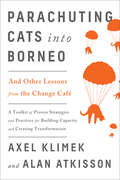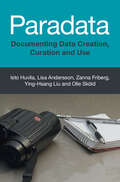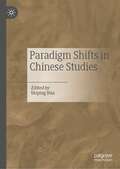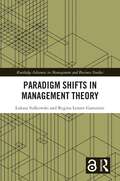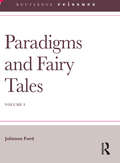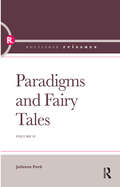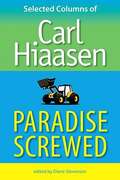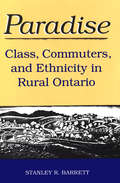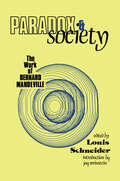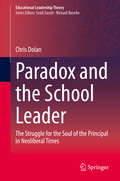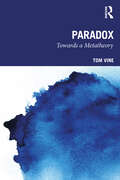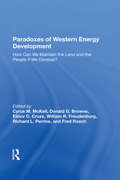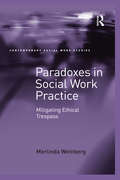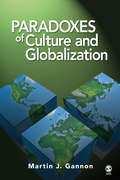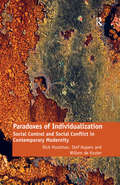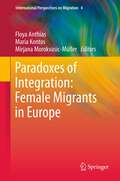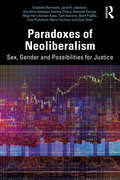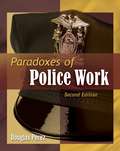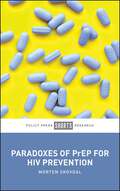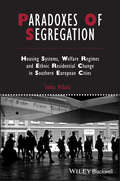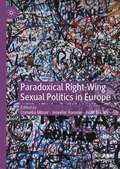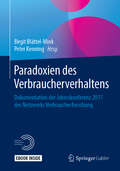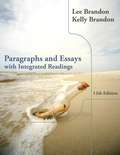- Table View
- List View
Parachuting Cats into Borneo: And Other Lessons from the Change Café
by Alan Atkisson Axel KlimekA toolkit of proven strategies and practices for building capacity and creating transformation Recent years have seen a proliferation of information on how to make change--in business, in social and environmental movements, and on a more personal scale. But, even with all this attention, two out of three change efforts fail to achieve their desired result. How can you make your own effort buck this trend? In Parachuting Cats into Borneo, change-management experts Axel Klimek and Alan AtKisson offer crisp, concise, and targeted advice for success. They expose the most significant impediments--helping readers recognize their habitual patterns of thinking and perceiving a situation, critique their own beliefs regarding change, and then move beyond these unhelpful patterns using improved systems thinking. Named after a classic tale of unintended consequences, Parachuting Cats into Borneo delivers tools that help leaders and others keep their change initiatives on track. The advice imparted will help you move away from agonizing over immediate problems toward stoking action, identifying collaborators, focusing at the right level for your cause, and aiding others in pursuing their change. Klimek and AtKisson draw from their decades of helping corporations, networks, governments, and NGOs reach their change goals to demonstrate how to use system-based change tools to their maximum advantage. A closing section is devoted to change making in the realm of sustainability, where complexity abounds but the right tools, used well, can help us tackle some of the most significant challenges of our time.
Paradata: Documenting Data Creation, Curation and Use
by Isto Huvila Ying-Hsang Liu Lisa Andersson Olle Sköld Zanna FribergTo make sense of data and use it effectively, it is essential to know where it comes from and how it has been processed and used. This is the domain of paradata, an emerging interdisciplinary field with wide applications. As digital data rapidly accumulates in repositories worldwide, this comprehensive introductory book, the first of its kind, shows how to make that data accessible and reusable. In addition to covering basic concepts of paradata, the book supports practice with coverage of methods for generating, documenting, identifying and managing paradata, including formal metadata, narrative descriptions and qualitative and quantitative backtracking. The book also develops a unifying reference model to help readers contextualise the role of paradata within a wider system of knowledge, practices and processes, and provides a vision for the future of the field. This guide to general principles and practice is ideal for researchers, students and data managers. This title is also available as open access on Cambridge Core.
Paradigm Shifts in Chinese Studies
by Shiping HuaThis book is a study of the change and continuity in paradigms in China studies, both inside and outside of China. In the last few years, the United States and China appeared to be moving in the direction of “de-coupling,” indicating that the engagement policy with China in the last four decade is ending. The “modernization theory” that is the theoretical foundation of the engagement policy has proved to be insufficient. This situation calls for a reexamination of the field of China studies. Historically, scholarly paradigms shifts often went hand in hand with drastic social change. As we have entered an era of great uncertainty, it is constructive to reflect on the paradigms in China studies in the past and explore the possibility of new paradigms in the future. How are the shifts of major theories, methods and paradigms in China studies in the west related to social change? How did some of China’s paradigms impact on the country’s social change and developments?This book will appeal to a wide readership, including scholars and graduate students, upper division undergraduate students of China studies, Asian studies.
Paradigm Shifts in Management Theory (Routledge Advances in Management and Business Studies)
by Łukasz Sułkowski Regina Lenart-GansiniecParadigm Shifts in Management Theory is an illuminating exploration of the evolving landscape of management science. This book goes beyond the surface, delving into profound insights and perspectives that redefine traditional paradigms.Through rigorous analysis and reflective narratives, each chapter unveils the transformative shifts shaping organizational leadership, offering a comprehensive understanding of key concepts and methodologies. From classical principles to emerging paradigms, elucidating the future of organizational leadership, readers will gain invaluable insights through empirical evidence and theoretical explorations, fostering a nuanced comprehension of practical applications. Advanced students, researchers, and practitioners will find that this book equips readers with essential knowledge to navigate the complexities of modern management science, fostering critical thinking and innovative approaches in real-world scenarios. Practitioners in organizational leadership benefit from practical insights and innovative perspectives, enhancing strategic decision-making and competitive advantage. Additionally, policymakers and interdisciplinary scholars exploring social phenomena find value in the interdisciplinary exchange facilitated by paradigm shifts. Embracing these shifts is crucial for advancing management science, ensuring its relevance and effectiveness in addressing contemporary challenges.Catering to a diverse audience within academia and professional settings, it serves students and researchers in management studies, offering a robust foundation in theoretical frameworks and research methodologies.
Paradigm and Ideology in Educational Research: The Social Functions of the Intellectual (Routledge Library Editions: Education)
by Thomas S PopkewitzThis book explores the complex social assumptions and values that underlie research programmes about schools. The analysis of educational research draws upon American and European scholarships in the sociology of knowledge, social philosophy and the history and sociology of science. The discussion considers first the communal, crafts and social characteristics of educational research. Three research models empirical-analytic, symbolic or linguistic and critical sciences are given attention. The discussion of the three research models is to illuminate how the constellation of commitments, assumptions and practices inter-relate to perform a paradigm giving different and conflicting definitions to the meaning of educational theory and to the use of the particular techniques of enquiry. The social role of educational research and the researcher is also considered.
Paradigms and Fairy Tales: Volume 1
by Julienne FordThis book is an introduction to the epistemology and practice of social science. It provides an exposition and critique of the ideology and practice of social science, and an examination of the professional social scientist as a manipulator of ideas and appearances.
Paradigms and Fairy Tales: Volume 2
by Julienne FordThis book is an introduction to the epistemology and practice of social science. It provides an exposition and critique of the ideology and practice of social science, and an examination of the professional social scientist as a manipulator of ideas and appearances.
Paradise Screwed: Selected Columns of Carl Hiaasen
by Carl Hiaasen Diane StevensonIn this book, Carl Hiaasen writes about politics and politicians, crime and criminals, ordinary people and extraordinary people, and a lot of just plain south Florida weirdness.
Paradise: Class, Commuters, and Ethnicity in Rural Ontario
by Stanley BarrettWhat was life like in the 1950s in small communities in Ontario? Lower-class and upper-class residents might have different memories of those days, but on one thing they would agree: it is a much different world in rural Ontario today. The old guard has lost most of its power, displaced partly by 'big brother' in the form of bureaucracy, and new comers from the city in search of affordable housing--even if it means commuting daily to work. Unlike their British-origin predecessors, the newcomers who have begun to appear in the countryside represent a wide range of ethnic and economic backgrounds.Paradise concentrates on the transformed class system of one community in rural Ontario. In a comparison of the decade following the First World War and the 1980s, Stanley R. Barrett analyses the changing face and structure of a town as it has had to adapt to modern social and economic realities. Particular attention is paid to the phenomenon of the commuter in search of affordable housing and the influx of immigrants of varied ethnic backgrounds, and the interaction between these newcomers and long-term residents. What is striking is just how massive the changes in small-town Ontario have been since the Second World War--to the extent of almost obliterating long-assumed distinctions between rural and urban society.
Paradox and Society: Work of Bernard Mandeville
by Louis SchneiderThe writings of Bernard Mandeville mark an important transition between enlightenment, social philosophy, and modern science. Born in Holland in 1670 and educated as a physician, Mandeville spent the greater part of his working life in England, where he died in 1733. In some respects, Mandeville can be compared to Voltaire - Mandeville's junior by twenty-four years.Mandeville had the knack of making controversies volcanic and of arousing heated debate about any topic on which he chose to comment - and he chose to comment on virtually everything. He was especially1 interested in social evolution, morality and society, prostitution and romantic love, crime and its deterrence, and in social aspects of religion. His views on these and countless other topics cohere in his continual fascination with the consequences of social and economic actions that run counter to anticipations and intentions and in the paradoxical or ironic cast that such outcomes often have. In Paradox and Society, Louis Schneider is the first to offer a full consideration of Mandeville as a sociologist.Schneider offers an intellectual and characterological portrait of Mandeville, examining his writings and reactions to him over time. Schneider goes on to review Mandeville's theory of human nature, and explores his hotly contested notion of the paradox of private vices and public benefits - that the arousal of desires is a necessary precondition for the stimulation of social and economic development.Social action outside the marketplace, and Mandeville's problematic theory of social evolution, are next considered. The volume ends with an examination of paradox, irony, and satire in society. In this detailed analysis of one of the world's most controversial social critics, Schneider shows us that Mandeville offers a vision of human society that is of enduring significance. He challenges the reader to consider how that vision might operate in today's world.
Paradox and the School Leader: The Struggle for the Soul of the Principal in Neoliberal Times (Educational Leadership Theory)
by Chris DolanThis book proposes that paradox, as a theoretically rich and historically enduring concept, has significant potential for researchers in the field of critical leadership studies. By enriching its general form and infusing it with added complexity and theoretical influence, it is argued that paradox can be legitimately applied as a lens for examining and as a pedagogy for realising new learning possibilities.The book takes paradoxes as formed out of the constitutive practices of discourse rather than as representations of conflict or complexity. Using fifteen paradoxes derived from theoretical and empirical analysis, it provides insights into the competing forces that contradict simplistic positivist accounts of contemporary school leadership and reveal the presence of a political struggle for the soul of the principal in the neoliberal era. It considers these paradoxes in three categories: (1) principal subjectivity and authority, (2) neoliberal policy and (3) managerial practice. The book advocates critique, counter-conduct and agonistic thought and practice as resources for principals participating in such a struggle, and employs Foucault's 'care of the self' and 'practices of freedom' to promote more active involvement of principals in authoring their ethical and political selves.
Paradox: Towards a Metatheory
by Tom VineHistory reveals countless attempts by great minds to solve life’s paradoxes. But what if these attempts miss the point? What if paradox is life? Contrary to the supposedly sublime linear logic that underpins our prevalent modes of theoretical and empirical enquiry, in this fascinating book, organizational anthropologist Tom Vine charts the pervasiveness of paradox across the academy: from arithmetic to zoology. In so doing, he reflects on the concept of paradox as a widespread existential ‘pattern’, a pattern which holds significant metatheoretical and pedagogical potential. Paradoxes, he argues, are not inconveniences or ‘fault lines in our common-sense world’ but are coded into our very existence. Paradoxes thus present their own vital logics that shape our lives: they thwart moral and ideological uniformity; they even out subjective experience between ‘the haves’ and ‘the have nots’; and they shed light on the opaque concepts of consciousness and agency. This book will appeal to anybody with a curious mind, particularly scholars and students with an interest in one or more of the following: complexity theory, critical pedagogies, ethnography, nonlinear dynamics, organization theory, and systems theory.
Paradoxes Of Western Energy Development: How Can We Maintain The Land And The People If We Develop?
by Cyrus M Mckell Donald G Browne Elinor C. Cruze William R FreudenburgProposed energy resource development in the arid western United States raises a number of potential problems for an environment that does not have a great deal of resiliency. Projected population increases associated with large-scale development activities may go beyond the capacity of small, isolated rural communities to absorb them; and constraints on western agricultural and industrial development—for example, demands for water already exceeding the supply available—also limit energy development. The authors of this wide-ranging book first evaluate western energy resources, then objectively discuss the consequences of development on the region’s physical and social environments. Among the questions they consider are: Who will reap the economic benefits of development, and who will bear the environmental costs? What will be the effects on the environment? The social structure? The quality of life? Are open spaces a national treasure in their present form, or should they be regarded as space available for development? What are the unique demands of reclamation in the arid west? And, given the recent trend of western states-rights militancy and shifts of population to the southwest, what impact will new federal and state policies have on resource management?
Paradoxes in Social Work Practice: Mitigating Ethical Trespass
by Merlinda WeinbergIn the helping professions, codes of ethics and decision-making models have been the primary vehicles for determining what constitutes ethical practice. These strategies are insufficient since they assume that shared meanings exist and that the contradictory universal principles of codes can be reconciled. Also, these tools do not emphasize the significance of context for ethical practice. This book takes a new critical theoretical approach, which involves exploring how social workers construct what is ’ethical’ in their work, especially when they are positioned at the intersection of multiple paradoxes, including that of two opposing responsibilities in society: namely, to care for others but also to prevent others from harm. The book is built on narratives from actual front-line workers and therefore is more applicable and grounded for practitioners and students, offering many suggestions for sound practice. It illustrates that an understanding of ethics differs from worker to worker and is heavily influenced by context, workers’ values, and what they take up as the primary discourses that frame their perceptions of the profession. While recognizing the oppressive potential of social work, the book is rooted in a perspective that ethical practice can contribute to a more socially just society.
Paradoxes of Culture and Globalization
by Martin J. Gannon"A truly extraordinary book! The range of knowledge revealed by the author is quite astonishing and the material presented is done so in a clear and unambiguous writing style."The book includes astonishingly varied perspectives on issues that will impact the hoped-for positive consequences of globalization. I felt I was being informed by an expert who grasps the complexity of the issues involved in ways that make them clear and useful. If I was teaching a course that had anything to do with globalization and/or culture, I would assign this book—and if I knew of someone who was being assigned to another country, I would require him or her to read this book."—Benjamin Schneider, Valtera Corporation and Professor Emeritus, University of MarylandWhat is a paradox? Why are cross-cultural paradoxes essential for understanding the changes that are occurring because of globalization? Encompassing a wide variety of areas including leadership, cross-cultural negotiations, immigration, religion, economic development, and business strategy, Paradoxes of Culture and Globalization develops cross-cultural paradoxes essential for understanding globalization. Key FeaturesHighlights over 90 paradoxes structured in a question/discussion format to actively engage readers and provide an integrative overview of the bookPresents key issues at a higher and integrative level of analysis to avoid stereotyping particular culturesFacilitates class discussions and the active involvement of class members in the learning process of culture and globalization.Enlarges individuals' conceptual understanding of cross-cultural issues Focuses on both traditional and controversial topics including motivation and leadership across cultures, communicating and negotiating across cultures, immigration, religion, geography, economic development, business strategy, and international human resource managementIntended AudienceThis is an excellent text for advanced undergraduate and graduate courses in International Management, International Business, Comparative Management, World Business Environment, Cross-Cultural Management, Cross-Cultural Communications, and Cultural Anthropology in the departments of business and management, communication, and anthropology.Meet author Martin J. Gannon! www.csusm.edu/mgannonMartin J. Gannon is also the author of the bestselling text Understanding Global Cultures (SAGE, Third Edition, 2004) and Cultural Metaphors: Readings, Research Translations, and Commentary (SAGE, 2000).
Paradoxes of Individualization: Social Control and Social Conflict in Contemporary Modernity
by Dick Houtman Stef Aupers Willem de KosterParadoxes of Individualization addresses one of the most hotly debated issues in contemporary sociology: whether a process of individualization is liberating selves from society so as to make them the authors of their personal biographies. The book adopts a cultural-sociological approach that firmly rejects such a notion of individualization as naïve. The process is instead conceptualized as an increasing social significance of moral notions of individual liberty, personal authenticity and cultural tolerance, which informs two paradoxes. Firstly, chapters about consumer behavior, computer gaming, new age spirituality and right-wing extremism demonstrate that this individualism entails a new, yet often unacknowledged, form of social control. The second paradox, addressed in chapters about religious, cultural and political conflict, is concerned with the fact that it is precisely individualism's increased social significance that has made it morally and politically contested. Paradoxes of Individualization, will therefore be of interest to scholars and students of cultural sociology, cultural anthropology, political science, and cultural, religious and media studies, and particularly to those with interests in social theory, culture, politics and religion.
Paradoxes of Integration: Female Migrants in Europe
by Mirjana Morokvasic-Müller Maria Kontos Floya AnthiasThis timely and innovative book analyses the lives of new female migrants in the EU with a focus on the labour market, domestic work, care work and prostitution in particular. It provides a comparative analysis embracing eleven European countries from Northern (UK, Germany, Sweden, France), Southern (Portugal, Spain, Italy, Greece, Cyprus) and Eastern Europe (Poland, Slovenia), i.e. old and new immigration countries as well as old and new market economies. It maps labour market trends, welfare policies, migration laws, patterns of employment, and the working and social conditions of female migrants in different sectors of the labour market, formal and informal. It is particularly concerned with the strategies women use to counter the disadvantages they face. It analyses the ways in which gender hierarchies are intertwined with other social relations of power, providing a gendered and intersectional perspective, drawing on the biographies of migrant women. The book highlights policy relevant issues and tries to uncover some of the contradictory assumptions relating to integration which it treats as a highly normative and problematic concept. It reframes integration in terms of greater equalisation and democratisation (entailed in the parameters of access, participation and belonging), pointing to its transnational and intersectional dimensions.
Paradoxes of Neoliberalism: Sex, Gender and Possibilities for Justice (Social Justice)
by Janet Jakobsen and Elizabeth BernsteinFrom the rise of far-right regimes to the tumult of the COVID-19 pandemic, recent years have brought global upheaval as well as the sedimentation of longstanding social inequalities. Analyzing the complexities of the current political moment in different geographic regions, this book addresses the paradoxical persistence of neoliberal policies and practices, in order to ground the pursuit of a more just world. Engaging theories of decoloniality, racial capitalism, queer materialism, and social reproduction, this book demonstrates the centrality of sexual politics to neoliberalism, including both social relations and statecraft. Drawing on ethnographic case studies, the authors show that gender and sexuality may be the site for policies like those pertaining to sex trafficking, which bundle together economics and changes to the structure of the state. In other instances, sexual politics are crucial components of policies on issues ranging from the growth of financial services to migration. Tracing the role of sexual politics across different localities and through different political domains, this book delineates the paradoxical assemblage that makes up contemporary neoliberal hegemony. In addition to exploring contemporary social relations of neoliberal governance, exploitation, domination, and exclusion, the authors also consider gender and sexuality as forces that have shaped myriad forms of community-based activism and resistance, including local efforts to pursue new forms of social change. By tracing neoliberal paradoxes across global sites, the book delineates the multiple dimensions of economic and cultural restructuring that have characterized neoliberal regimes and emergent activist responses to them. This innovative analysis of the relationship between gender justice and political economy will appeal to: interdisciplinary scholars in social and cultural studies; legal and political theorists; and the wide range of readers who are concerned with contemporary questions of social justice.
Paradoxes of Police Work (Second Edition)
by Douglas W. Perez<p>Through the eyes of a former police officer, <i>Paradoxes of Police Work</i>, 2nd edition leads the reader through the policies and inherent contradictions of law enforcement as described with real cop experiences and realities. In tell it like it is fashion, this book offers examples of real-life situations that occur constantly in the day-to-day operations of routine patrol and offers glimpses into the frustrations and stresses of law enforcement careers. <p><i>Paradoxes of Police Work</i>, 2nd edition tackles subjects that many academic texts and field books too often ignore. Controversial issues are often glossed over in other books, but their importance cannot be dismissed. Confronting them can lead to a better understanding of the profession, which can in turn create better professionals. Whether the book is used as a reader to support an academic course or in law enforcement training, the thought-provoking and insightful topic coverage clarifies the paradoxes in modern police work. <i>Paradoxes of Police Work</i>, 2nd edition is strongly suggested for introductory courses and academies, as well as for anyone considering a career in law enforcement. </p>
Paradoxes of PrEP for HIV Prevention
by Morten SkovdalAvailable open access digitally under CC-BY licence. Pre-exposure prophylaxis (PrEP) is a drug taken by HIV-negative people that reduces the risk of getting HIV. Comparing two case studies in Denmark and Zimbabwe, this book demonstrates six paradoxes that users often encounter in navigating their PrEP journey. These paradoxes lead to contentions, uncertainties, dilemmas and ambiguities that need to be carefully and pensively responded to through what the author terms ‘everyday PrEP negotiations’. The social nature and need for such everyday PrEP negotiations help explain why PrEP works for some people and not for others. This book argues that such insight is critical to make PrEP work for more people and to inform social public health responses.
Paradoxes of Segregation: Housing Systems, Welfare Regimes and Ethnic Residential Change in Southern European Cities (IJURR Studies in Urban and Social Change Book Series)
by Sonia ArbaciThrough an international comparative research, this unique book examines ethnic residential segregation patterns in relation to the wider society and mechanisms of social division of space in Western European regions. Focuses on eight Southern European cities, develops new metaphors and furthers the theorisation/conceptualisation of segregation in Europe Re-centres the segregation debate on the causes of marginalisation and inequality, and the role of the state in these processes A pioneering analysis of which and how systemic mechanisms, contextual conditions, processes and changes drive patterns of ethnic segregation and forms of socio-ethnic differentiation Develops an innovative inter-disciplinary approach which explores ethnic patterns in relation to European welfare regimes, housing systems, immigration waves, and labour systems
Paradoxical Right-Wing Sexual Politics in Europe (Global Queer Politics)
by Cornelia Möser Jennifer Ramme Judit TakácsHow did far-right, hateful and anti-democratic ideologies become so successful in many societies in Europe? This volume analyses the paradoxical roles sexual politics have played in this process and reveals that the incoherence and untruthfulness in right-wing populist, ultraconservative and far-right rhetorics of fear are not necessarily signs of weakness. Instead, the authors show how the far right can profit from its own incoherence by generating fear and creating discourses of crisis for which they are ready to offer simple solutions. In studies on Poland, Hungary, Spain, Italy, Austria, Ireland, Northern Ireland, Portugal, France, Sweden and Russia, the ways far-right ideologies travel and take root are analysed from a multi-disciplinary perspective, including feminist and LGBTQI reactions. Understanding how hateful and antidemocratic ideologies enter the very centre of European societies is a necessary premise for developing successful counterstrategies.
Paradoxien des Verbraucherverhaltens: Dokumentation der Jahreskonferenz 2017 des Netzwerks Verbraucherforschung
by Birgit Blättel-Mink Peter KenningDieses Buch informiert sie eingehend über die VerbraucherforschungDas Konsumentenverhalten ist für Unternehmen eine wichtige Kennzahl, um Marketingstrategien erfolgreich gestalten zu können. Nur wer seine Zielgruppe kennt, kann auf deren Bedürfnisse und Wünsche eingehen. Die wissenschaftliche Konferenz des Netzwerks Verbraucherforschung aus dem Jahr 2017 hatte zum Ziel, Paradoxien, Widersprüche und Ambivalenzen im Consumer Behaviour aufzudecken. Die Ergebnisse der Konferenz wurden in diesem Buch zur Verbraucherforschung festgehalten und analysiert.Neben der Thematisierung des verbraucherwissenschaftlichen Kontextes waren auch Sprecher aus der Politik an der Konferenz beteiligt. Aus diesem Grund werden auch die politischen Konsequenzen des Verhaltens von Verbrauchern in diesem Tagungsband diskutiert. Das Buch über die Verbraucherforschung berücksichtigt aktuelle Forschungsergebnisse. Gleichzeitig identifiziert es Forschungspotentiale für die Zukunft. Den Autoren ist es wichtig, nicht nur Wissenschaftlern einen Zugang zu diesem Wissen und den Erfahrungen zu liefern, sondern auch praxisbezogene Leser anzusprechen.Folgende Thematiken werden behandelt:Privatheit und Datenschutz beim Online-ShoppingParadoxien der Nutzung von IT-SystemenDas Spannungsverhältnis von Mode und nachhaltigem KonsumWidersprüche der Digitalisierung und des nachhaltigen KonsumsVerbraucherpolitische ImplikationenKonsequenzen für die Verbraucher- und KonsumforschungDie Podiumsdiskussionen der Konferenz von 2017 werden in diesem Buch zur Verbraucherforschung aus allen Sichten dargestellt, sodass der Leser ein differenziertes Bild aktueller Diskussionen erhält.
Paragraphs and Essays: With Integrated Readings (12th Edition)
by Kelly Brandon Lee BrandonThis classic text offers comprehensive, proven instruction in developmental writing. Paragraphs and Essays: With Integrated Readings is the higher-level companion to Sentences, Paragraphs, and Beyond in the bestselling two-book Brandon series. Instruction in this text--comprehensive, flexible, and relevant--is predicated on the idea that reading and writing are linked and that good writing is the product of thoughtful and systematic revision.
Parallel Lives: An Empirical Exploration of the Concept of Generation
by Calin GoinaThis book explores the articulation between macro-social historical transformations and the opportunities and constraints that the resultant political and property regimes presented for villagers. It builds on ethnographic analyses of rural Eastern Europe by adding an historical analysis of the configurations and reconfigurations of life trajectories across three successive generations. The villagers studied lived a succession of property and political configurations: democratic and authoritarian regimes grounded in free market and private property until 1947, a totalitarian regime of state-socialism until 1989, and a liberal democracy re-building a free market economy from 1990 until today. It also brings forward an empirical exploration of the concept of generation, grounded on a re-reading of Karl Mannheim. The book is distinctive in its historical breath, covering a century via a detailed, rich ethnographic study, that includes a diversity of social positions (from the richest members of the community to those of very poor means) and a diversity of three ethnicities and religions.
